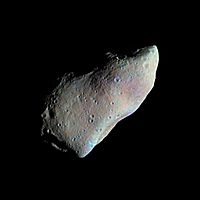(951) Gaspra
|
Asteroid (951) Gaspra |
|
|---|---|
| Properties of the orbit ( animation ) | |
| Orbit type | Main girdle asteroid , Flora family |
| Major semi-axis | 2.209 AU |
| eccentricity | 0.179 |
| Perihelion - aphelion | 1.825 AU - 2.834 AU |
| Inclination of the orbit plane | 13.731 ° |
| Sidereal period | 3,285 a |
| Mean orbital velocity | 18.19 km / s |
| Physical Properties | |
| Dimensions | 19 × 12 × 11 km |
| Dimensions | 10 15 kg |
| Rotation period | 7.042 h |
| Absolute brightness | 11,496 likes |
| Spectral class | S. |
| history | |
| Explorer | G. N. Neuimin |
| Date of discovery | July 30, 1916 |
| Another name | 1916 S 45 , 1955 SM 1 , A913 YA |
| Source: Unless otherwise stated, the data comes from JPL Small-Body Database Browser . The affiliation to an asteroid family is automatically determined from the AstDyS-2 database . Please also note the note on asteroid items. | |
(951) Gaspra is an asteroid of the main asteroid belt discovered on July 30, 1916 by the Ukrainian astronomer G. N. Neuimin (Григорий Николаевич Неуймин). Gaspra was named after the holiday resort Gaspra in the Crimea , where the Russian writer Leo Tolstoy lived for a long time.
Gaspra moves from 1.8256 ( perihelion ) to 2.5939 ( aphelion ) astronomical units around the sun in 3.285 years . The orbit is inclined 4.1016 ° to the ecliptic , the orbital eccentricity is 0.1739. This means that Gazpra's orbit runs along the inner edge of the main belt. Gaspra is a member of the Flora family .
Gaspra was measured and photographed on October 29, 1991 by the space probe Galileo (named after Galileo Galilei ) during a near flyby maneuver at a distance of 1600 km.
This made the Galileo mission the first of its kind to collect information about an asteroid using such a maneuver, and Gaspra was the first asteroid to be photographed from close up.
It turned out that Gaspra is an irregularly shaped asteroid with dimensions of 19 × 12 × 11 kilometers. The surface is littered with numerous impact craters . By measuring the size and distribution of the craters, Gazpra's age is estimated to be 200 million years. Measured against the 4.5 billion years of the solar system, this is an early age. Gaspra is therefore likely to be a fragment of a larger original body that was torn apart in a collision 200 million years ago. The mass of Gaspra was determined to be 10 15 kg . The rotation period is 7 hours and 3 minutes. Due to its surface properties, the asteroid is assigned to the spectral class S.
